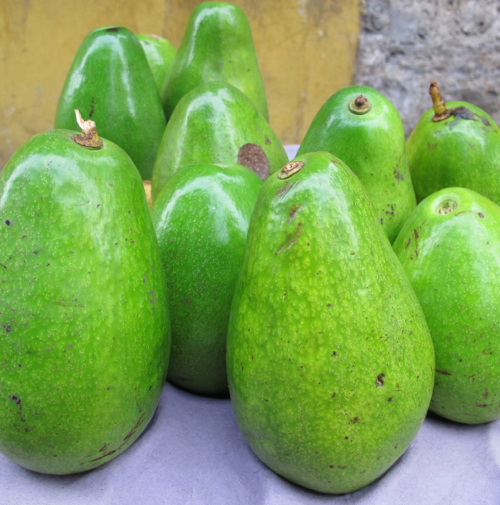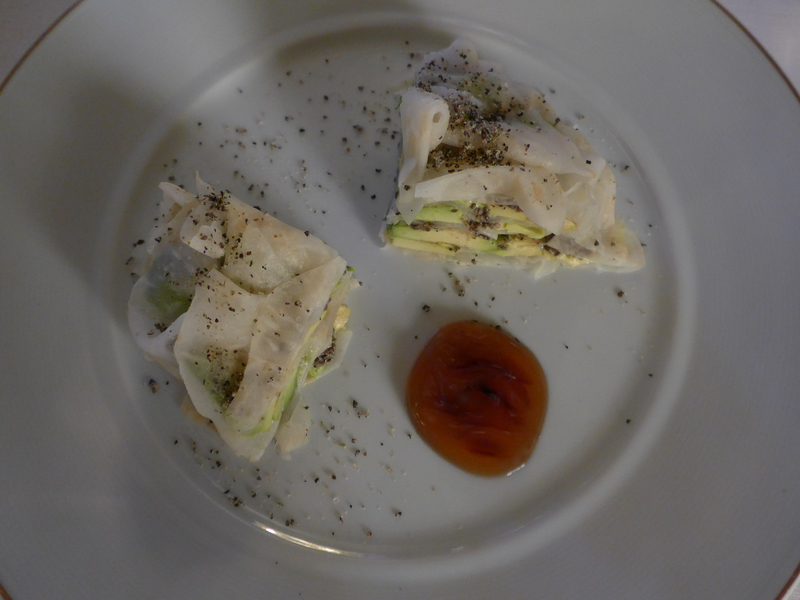Avocado: a fruit that is not sweet but versatile
Native to Central America and particularly Mexico, this green thick-skinned fruit is often confused with being a vegetable. No wonder, since avocado is not sweet, but rather creamy when ripe and is more used in savory recipes. Being grown on a lemon-sized leafy tree and having a nutty hard seed (pit) inside qualify it as a fruit.
Like with apples, the varieties of avocados span towards a hundred. In California as the land itself, these thick-skinned fruits are of a Mexican heritage. The giant Australian avocados are recognisable on the first sight and often exported across Asia, but I have seen them also growing in Colombia, from where they probably sailed from. In Europe they grow around the Mediterranean, but are mostly imported from Morocco and Spain. Their popularity in Florida inspired plantings of the West Indian or Guatemalan hybrids, while in Hawaii there are hundreds of genetically distinct varieties.
In South America, Mexico, Colombia and Brazil lead their native plantings. Today, even China and Indonesia grow avocados, amounting to a truly global phenomena. The climate needs to be warmer than for apples though so they do not fare well in Northern countries.
You can keep the seed and even plant your own tree like the organic farm Via Organica in Mexico does.

Some are pear shaped (Malama, Zutano), others more oval like an egg (Sharwill, Linda) and there are even ball-shaped (Naranjo) avocados! All these varietals can be confusing, so I sum the most common species here.
The dark blue, like corn tortilla chips coloured Hass avocado is the most commercial. It withstands pressure well, and is grown anywhere from California to New Zealand. It belongs to the Guatemalan strain together with Fuerte and Reed varietals that are ultra rich in oil content and loved for their buttery flavour. Of the Florida avocados the large and shiny Booth, Lula and Taylor are West Indian hybrids with just a mild taste since they contain less oil than the Guatemalan strain.
Depending on season, you will find different avocados across Mexico. The creamy and light Bacon and Zutano get most fans. The Bacon avocado has a slightly brown skin and is easy to peel, while Zutano is a pear-shaped fruit, with yellow-green skin.
Avocados are not just a staple of Mexican diet, but also became popular with vegetarians and vegans, because of their generous nutritional values.


Health benefits
Avocados are full of healthy monounsaturated fats and a ton of vitamins. Vitamin E for youthful skin, A, C, D, K, folic acid, more than a double of potassium than banana. Because avocados contain high amounts of folate, they may help with fighting depression, cancer prevention, and preventing birth defects. Avocados also contain high amounts of fibre which is shown to decrease lower blood pressure and cholesterol, as well as improve digestion. Devon Dionne, a certified health coach, suggests avocados as a great alternative to dairy and high sugar fruits like bananas. “I recommend using avocados for those that are lactose intolerant but love creamy textures such as ice cream, puddings and mayonnaise. I also use avocados to replace bananas in smoothies for those interested in weight loss or at risk for diabetes. It gives the smoothie the creamy texture of a banana without all the added sugar.”
Devone’s guilt-free dessert recipe:
Chocolate Avocado Pudding
Ingredients
1 ripe avocado
3-4 Tbsp raw cacao powder
6 Tbsp coconut milk
2 teaspoons maple syrup
1 teaspoon almond butter
1 teaspoon vanilla
pinch of salt
Directions
Cut avocado in half and remove pit. Scoop out flesh and place into a food processor or blender. Add the remaining ingredients. Process or blend until creamy. Chill in refrigerator for at least an hour before serving.
———–
Radka’s summer treat:
Avocado Sorbet
In the summer I love this dairy-free avocado treat that is simple to make and refreshing. For a longer-kept creamy texture, use a sorbet maker.
3 ripe avocados
2-3 Tbsp freshly squeezed lime juice
3-4 Tbsp coconut sap sugar or rice syrup
pinch of salt
If you don’t have a sorbet maker, use a high speed blender (I have great experience with Vitamix) and whip until smooth, transfer into a sealed glass container and put in the freezer for at least four hours. It will keep for about a week. The more often you take it out from the freezer, the less consistent the texture will stay.
———-




Further use and tips:
In the kitchen this cholesterol-free butter can thicken desserts without the use of cream and any other animal produce. It is also perfect for smoothies instead of ice cream, you can make a dairy-free gelato from it. For the later, just mix a ripe avocado with coconut or other nut milk and coconut sugar or agave syrup in a high speed blender and voila, a heathy treat either as a pudding or freeze it for three to four hours for an ice-cream. Avocado, almond and frisé California salad at Malibu Farm dressed only with lemon vinaigrette is perfect light but filling lunch salad. Another hip outing along the Pacific, Gjelina pairs the avocado with cooked beets, roasted hazelnuts, and segmented oranges. Of course the famous avocado toast can be made healthier too. Using wholegrain seeded bread, smashed ripe avocado can be mixed with little white vinegar or lemon juice, and topped with sprouts, chia and flax seeds for an omega boost, Flax and Seed in Barcelona found the perfect healthy breakfast. I also had a superb Sydney meets New York version at Five Hands Cafe on Manhattan. The French takes with avocado are more indulgent. King crab, green apples and lime over avocado tartare in the casual bistro or the finest avocado dish I have ever had at the three Michelin star Ledoyen in Paris. There, the ripe avocado was layered with raw turnip, ground flax seed and a savoury condiment.
An intriguing scoop to finish. Most of you know it being imported mainly from Australia, Brazil, Mexico, California, Florida or Spain, but avocado is grown even in Laos and Italy.

